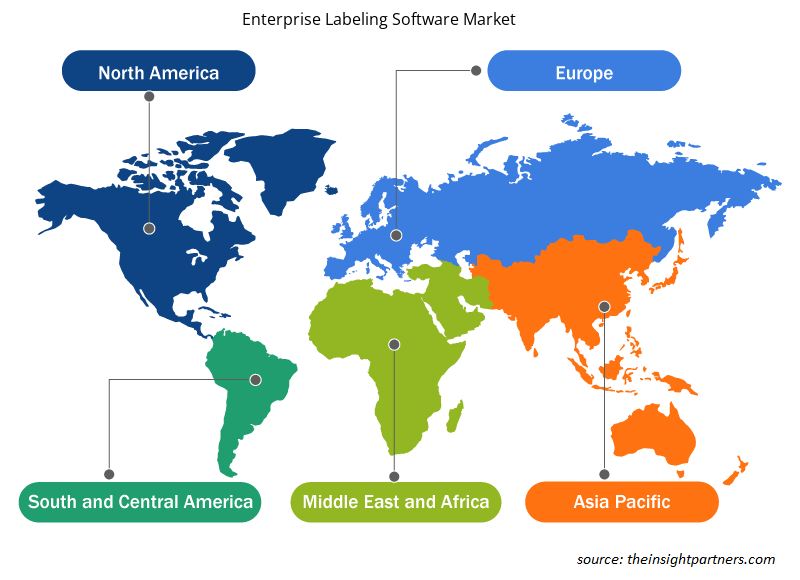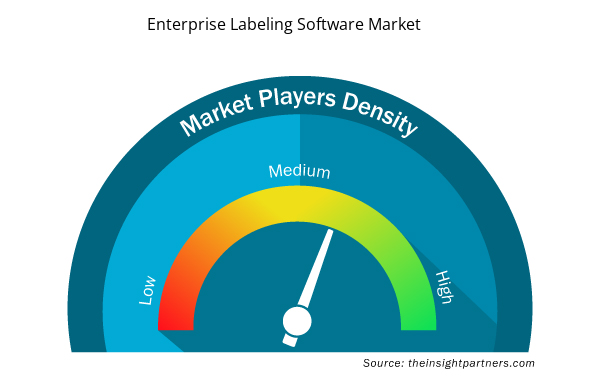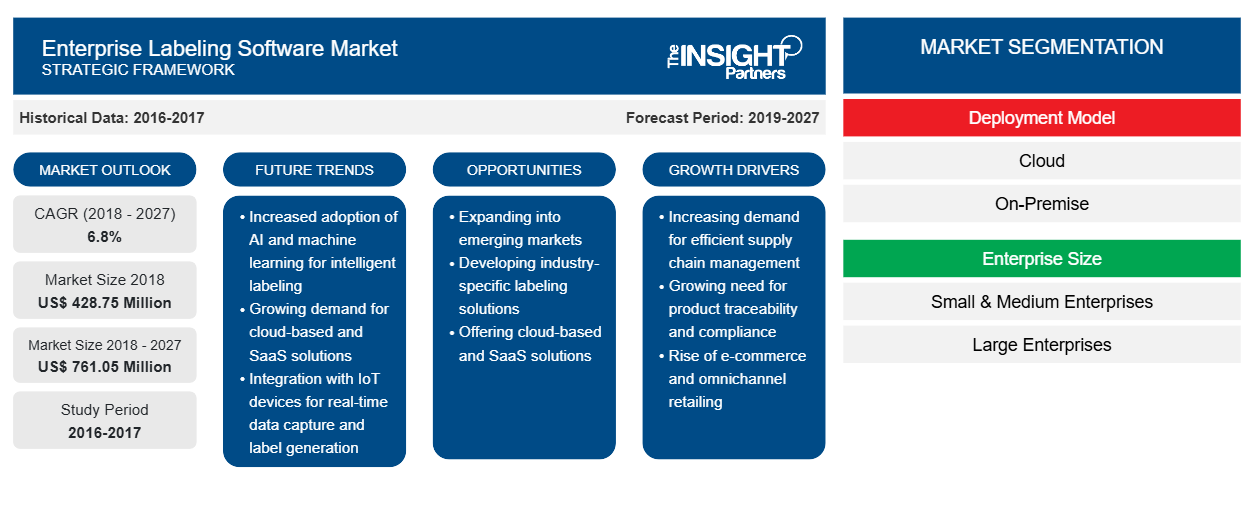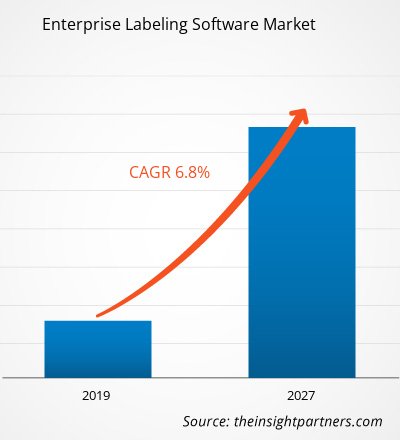Nel 2018, il mercato del software per l'etichettatura aziendale era valutato 428,75 milioni di dollari USA e si prevede che raggiungerà i 761,05 milioni di dollari USA entro il 2027, con un tasso di crescita CAGR del 6,8% nel periodo di previsione.
L'espansione di vari settori di utilizzo finale in tutto il mondo, in particolare in APAC e MEA, insieme all'evoluzione della gestione e pianificazione dei dati negli ultimi anni, ha introdotto l'etichettatura come un'operazione critica per il business di molte piccole e medie imprese. C'è una crescente necessità di etichettatura aziendale in vari settori di utilizzo finale per semplificare più operazioni aziendali. Il software di etichettatura aziendale aiuta a mantenere l'accuratezza durante il processo di stampa e garantisce la conformità delle aziende alle normative sulla divulgazione delle informazioni sui prodotti. Inoltre, l'integrazione di questo software offre vari vantaggi, tra cui la collaborazione dei dati a livello aziendale, l'efficienza della supply chain e la flessibilità e la coerenza della stampa delle etichette. Pertanto, si prevede che la maggiore adozione dell'etichettatura aziendale guiderà la crescita del mercato del software di etichettatura aziendale
Il software di etichettatura aziendale migliora velocità, accuratezza, efficienza, risparmio sui costi e tempi di consegna, consentendo alle aziende di affrontare complesse sfide di etichettatura. La qualità di etichettatura migliorata aiuta a migliorare il vantaggio competitivo dell'azienda nel mercato globale.
Personalizza questo report in base alle tue esigenze
Riceverai la personalizzazione gratuita di qualsiasi report, comprese parti di questo report, o analisi a livello nazionale, pacchetto dati Excel, oltre a usufruire di grandi offerte e sconti per start-up e università
- Scopri le principali tendenze di mercato in questo rapporto.Questo campione GRATUITO includerà analisi di dati che spaziano dalle tendenze di mercato alle stime e alle previsioni.
Approfondimenti regionali sul mercato del software di etichettatura aziendale
Le tendenze regionali e i fattori che influenzano il mercato del software di etichettatura aziendale durante il periodo di previsione sono stati ampiamente spiegati dagli analisti di Insight Partners. Questa sezione discute anche i segmenti e la geografia del mercato del software di etichettatura aziendale in Nord America, Europa, Asia Pacifico, Medio Oriente e Africa e America meridionale e centrale.

- Ottieni i dati specifici regionali per il mercato del software di etichettatura aziendale
Ambito del rapporto di mercato sul software di etichettatura aziendale
| Attributo del report | Dettagli |
|---|---|
| Dimensioni del mercato nel 2018 | 428,75 milioni di dollari USA |
| Dimensioni del mercato entro il 2027 | 761,05 milioni di dollari USA |
| CAGR globale (2018 - 2027) | 6,8% |
| Dati storici | 2016-2017 |
| Periodo di previsione | 2019-2027 |
| Segmenti coperti | Per modello di distribuzione
|
| Regioni e Paesi coperti | America del Nord
|
| Leader di mercato e profili aziendali chiave |
|
Densità dei player del mercato del software di etichettatura aziendale: comprendere il suo impatto sulle dinamiche aziendali
Il mercato del software di etichettatura aziendale sta crescendo rapidamente, spinto dalla crescente domanda degli utenti finali dovuta a fattori quali l'evoluzione delle preferenze dei consumatori, i progressi tecnologici e una maggiore consapevolezza dei vantaggi del prodotto. Con l'aumento della domanda, le aziende stanno ampliando le loro offerte, innovando per soddisfare le esigenze dei consumatori e capitalizzando sulle tendenze emergenti, il che alimenta ulteriormente la crescita del mercato.
La densità degli operatori di mercato si riferisce alla distribuzione di aziende o società che operano in un particolare mercato o settore. Indica quanti concorrenti (operatori di mercato) sono presenti in un dato spazio di mercato in relazione alle sue dimensioni o al valore di mercato totale.
Le principali aziende che operano nel mercato del software per l'etichettatura aziendale sono:
- Software BLU, LLC
- Società CYBRA
- Sistemi di dati internazionali, Inc. (DSI)
- Endicia,
- Euro Plus Ltd.
Disclaimer : le aziende elencate sopra non sono classificate secondo un ordine particolare.

- Ottieni una panoramica dei principali attori del mercato dei software di etichettatura aziendale
Gli attori che operano nel mercato dell'enterprise content management si concentrano su strategie quali fusioni, acquisizioni e iniziative di mercato per mantenere le loro posizioni nel mercato. Di seguito sono elencati alcuni sviluppi da parte degli attori chiave:
- A novembre 2019, NiceLabel ha lanciato la versione 2 del suo pacchetto ABAP, che supporta sia SAP ECC che SAP S/4HANA. Ciò consente alle organizzazioni di digitalizzare completamente il processo di garanzia della qualità dell'etichettatura e di ridurre sia gli errori di etichettatura sia i ritardi di spedizione.
- Nell'aprile 2018, Innovatum, Inc. ha annunciato la certificazione ISO 9001:2015 per il suo sistema di gestione della qualità per lo sviluppo, la distribuzione e il supporto del software in qualità di fornitore di software per le scienze della vita, da parte di un organismo accreditato ANAB.
Segmenti di mercato globali del software di etichettatura aziendale:
Mercato del software di etichettatura aziendale – Per modello di distribuzione
- In sede
- Nuvola
Mercato del software di etichettatura aziendale – Per dimensione aziendale
- Piccola e media impresa
- Grande impresa
Mercato del software di etichettatura aziendale – per utente finale
- Beni di largo consumo
- Vedere al dettaglio
- Assistenza sanitaria
- Magazzinaggio e logistica
- Altri
Mercato del software di etichettatura aziendale – Per area geografica
America del Nord
- NOI
- Canada
- Messico
Europa
- Francia
- Germania
- Italia
- Spagna
- Regno Unito
- Resto d'Europa
Asia Pacifico (APAC)
- Australia
- Cina
- India
- Giappone
- Resto dell'APAC
Medio Oriente e Africa (MEA)
- Arabia Saudita
- Emirati Arabi Uniti
- Sudafrica
- Resto del MEA
America del Sud (SAM)
- Brasile
- Resto del SAM
Aziende
- Software BLU, LLC (Esko)
- Società CYBRA
- Sistemi di dati internazionali, Inc. (DSI)
- Endicia
- Euro Plus Ltd
- Innovatum, Inc.
- Loftware, Inc.
- Società a responsabilità limitata
- Seagull Scientific, Inc.
- Teklynx Newco SAS
- Analisi storica (2 anni), anno base, previsione (7 anni) con CAGR
- Analisi PEST e SWOT
- Valore/volume delle dimensioni del mercato - Globale, regionale, nazionale
- Industria e panorama competitivo
- Set di dati Excel



Report Coverage
Revenue forecast, Company Analysis, Industry landscape, Growth factors, and Trends

Segment Covered
This text is related
to segments covered.

Regional Scope
North America, Europe, Asia Pacific, Middle East & Africa, South & Central America

Country Scope
This text is related
to country scope.
Domande frequenti
Various end-use industries have used reporting solutions and business intelligence (BI) with many of their enterprise applications to improve business operations. Companies are looking forward to using BI to monitor labels printed across facilities to ensure that the quality of labels printed is in line with the expected output of a facility. Moreover, they are looking forward to using this insight for better maintenance schedules for printers and analyzing trends in the label production to fine-tune labeling environments. Therefore, the use of analytics with enterprise labeling is a major emerging trend for enterprise labeling software market.
The growth of the enterprise labeling software market in Europe is primarily attributed to the strong retail industry in countries such as India, China, and Japan, owing to the strong customer base. Also, the FMCG industry in countries such as India and China plays a vital role in supporting any country’s economy. Since the demand for enterprise labeling software is high across the FMCG sector; therefore, a strong FMCG sector supports the increasing demand for enterprise labeling software in the region.
The growing demand for enterprise labeling software in end-use industries in emerging economies such as MEA and APAC is driving the growth of enterprise labeling software market. Also, the surging demand for flexible enterprise labeling solutions to reduce the inconsistency, and improve efficiency is also a major driving factor for the enterprise labeling software market.
Trends and growth analysis reports related to Technology, Media and Telecommunications : READ MORE..
The List of Companies
- BLUE Software, LLC
- CYBRA Corporation
- Data Systems International, Inc. (DSI)
- Endicia,
- Euro Plus Ltd.
- Innovatum, Inc.
- Loftware, Inc.
- PRISYM ID Ltd.
- Seagull Scientific, Inc.
- Teklynx Newco SAS.
The Insight Partners performs research in 4 major stages: Data Collection & Secondary Research, Primary Research, Data Analysis and Data Triangulation & Final Review.
- Data Collection and Secondary Research:
As a market research and consulting firm operating from a decade, we have published and advised several client across the globe. First step for any study will start with an assessment of currently available data and insights from existing reports. Further, historical and current market information is collected from Investor Presentations, Annual Reports, SEC Filings, etc., and other information related to company’s performance and market positioning are gathered from Paid Databases (Factiva, Hoovers, and Reuters) and various other publications available in public domain.
Several associations trade associates, technical forums, institutes, societies and organization are accessed to gain technical as well as market related insights through their publications such as research papers, blogs and press releases related to the studies are referred to get cues about the market. Further, white papers, journals, magazines, and other news articles published in last 3 years are scrutinized and analyzed to understand the current market trends.
- Primary Research:
The primarily interview analysis comprise of data obtained from industry participants interview and answers to survey questions gathered by in-house primary team.
For primary research, interviews are conducted with industry experts/CEOs/Marketing Managers/VPs/Subject Matter Experts from both demand and supply side to get a 360-degree view of the market. The primary team conducts several interviews based on the complexity of the markets to understand the various market trends and dynamics which makes research more credible and precise.
A typical research interview fulfils the following functions:
- Provides first-hand information on the market size, market trends, growth trends, competitive landscape, and outlook
- Validates and strengthens in-house secondary research findings
- Develops the analysis team’s expertise and market understanding
Primary research involves email interactions and telephone interviews for each market, category, segment, and sub-segment across geographies. The participants who typically take part in such a process include, but are not limited to:
- Industry participants: VPs, business development managers, market intelligence managers and national sales managers
- Outside experts: Valuation experts, research analysts and key opinion leaders specializing in the electronics and semiconductor industry.
Below is the breakup of our primary respondents by company, designation, and region:

Once we receive the confirmation from primary research sources or primary respondents, we finalize the base year market estimation and forecast the data as per the macroeconomic and microeconomic factors assessed during data collection.
- Data Analysis:
Once data is validated through both secondary as well as primary respondents, we finalize the market estimations by hypothesis formulation and factor analysis at regional and country level.
- Macro-Economic Factor Analysis:
We analyse macroeconomic indicators such the gross domestic product (GDP), increase in the demand for goods and services across industries, technological advancement, regional economic growth, governmental policies, the influence of COVID-19, PEST analysis, and other aspects. This analysis aids in setting benchmarks for various nations/regions and approximating market splits. Additionally, the general trend of the aforementioned components aid in determining the market's development possibilities.
- Country Level Data:
Various factors that are especially aligned to the country are taken into account to determine the market size for a certain area and country, including the presence of vendors, such as headquarters and offices, the country's GDP, demand patterns, and industry growth. To comprehend the market dynamics for the nation, a number of growth variables, inhibitors, application areas, and current market trends are researched. The aforementioned elements aid in determining the country's overall market's growth potential.
- Company Profile:
The “Table of Contents” is formulated by listing and analyzing more than 25 - 30 companies operating in the market ecosystem across geographies. However, we profile only 10 companies as a standard practice in our syndicate reports. These 10 companies comprise leading, emerging, and regional players. Nonetheless, our analysis is not restricted to the 10 listed companies, we also analyze other companies present in the market to develop a holistic view and understand the prevailing trends. The “Company Profiles” section in the report covers key facts, business description, products & services, financial information, SWOT analysis, and key developments. The financial information presented is extracted from the annual reports and official documents of the publicly listed companies. Upon collecting the information for the sections of respective companies, we verify them via various primary sources and then compile the data in respective company profiles. The company level information helps us in deriving the base number as well as in forecasting the market size.
- Developing Base Number:
Aggregation of sales statistics (2020-2022) and macro-economic factor, and other secondary and primary research insights are utilized to arrive at base number and related market shares for 2022. The data gaps are identified in this step and relevant market data is analyzed, collected from paid primary interviews or databases. On finalizing the base year market size, forecasts are developed on the basis of macro-economic, industry and market growth factors and company level analysis.
- Data Triangulation and Final Review:
The market findings and base year market size calculations are validated from supply as well as demand side. Demand side validations are based on macro-economic factor analysis and benchmarks for respective regions and countries. In case of supply side validations, revenues of major companies are estimated (in case not available) based on industry benchmark, approximate number of employees, product portfolio, and primary interviews revenues are gathered. Further revenue from target product/service segment is assessed to avoid overshooting of market statistics. In case of heavy deviations between supply and demand side values, all thes steps are repeated to achieve synchronization.
We follow an iterative model, wherein we share our research findings with Subject Matter Experts (SME’s) and Key Opinion Leaders (KOLs) until consensus view of the market is not formulated – this model negates any drastic deviation in the opinions of experts. Only validated and universally acceptable research findings are quoted in our reports.
We have important check points that we use to validate our research findings – which we call – data triangulation, where we validate the information, we generate from secondary sources with primary interviews and then we re-validate with our internal data bases and Subject matter experts. This comprehensive model enables us to deliver high quality, reliable data in shortest possible time.


 Ottieni un campione gratuito per questo repot
Ottieni un campione gratuito per questo repot